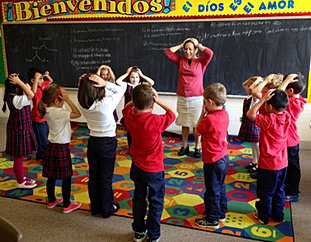How shall we introduce language to beginners?
A good percentage of students who come to Tamil school are first time learners of Tamil. They may have heard or not heard any Tamil. We want them to learn Tamil, speak, read, and write. These students are exposed to English and learning Tamil is foreign to them even though it is their mother tongue. What is the easy way to introduce Tamil to them? Several ways such as grammar-translation, communicative approach etc are available. But, what will be an effective way? What ways will help the kids to acquire Tamil better and also enjoy the Tamil class?
This post explores a traditional approach, a better method, and also suggests an improvement to the popular TPR technique.
This post explores a traditional approach, a better method, and also suggests an improvement to the popular TPR technique.
Traditional approach
In a traditional approach we start with letters, words, grammar rules, and move up. As Dr. Krashen says this is conscious learning and it is limited.
Communicative approach
A better way is to teach using communicative approach. A popular technique to introduce language to beginner in communicative approach is Total Physical Response (TPR) by Dr. James Asher of San Jose State University. After several years of research he found that it is effective to introduce language using actions. TPR suggests that we teachers take a list of commonly used actionable verbs, model it, ask the learners to repeat, and gradually make them to do the action without modelling.


A better way
No doubt TPR is a great way to introduce language to beginners. However, one thing is missing. When a learner starts a language course he/she may be good to follow the TPR direction and do the action. But, after sometime he/she may get bored with this. So, how do we make this interesting? How do we make this compelling. Sit/stand/walk sequence may be useful to learn the words, but how interesting could that be?
Purposeful TPR
What if we make this meaningful/purposeful? What if the learners learn something in addition to the language? Here is an idea.
An Example
The very first TPR lesson is sit/stand/ sequence. What if we teach the learners to do ThoppukkaraNam (தோப்புக்கரணம்)? ThoppukkaraNam is a form of physical exercise proven to help improve well being. Using this idea we can still teach the same words as the TPR first lesson.
Here is the sequence. Using informal Tamil to keep the instruction simple, at least for the first lesson.
எழுந்திரு
உக்காரு
கையை தூக்கு
காதை தொடு
அந்த கையை தூக்கு
இன்னொரு காதை தொடு
உக்காரு
எழுந்திரு
Repeat this several times using TPR technique and they will acquire the following words in this one lesson.
எழுந்திரு, உக்காரு, கை, தூக்கு, காது, தொடு, அந்த, இன்னொரு
About 8 words and phrases, a good number for the first class.
One problem with this approach is that the TPR technique suggests we change the order of the instruction. In case of a fixed purpose changing the order may not be possible in some cases.
One problem with this approach is that the TPR technique suggests we change the order of the instruction. In case of a fixed purpose changing the order may not be possible in some cases.
Conclusion
They not only learn the words and phrases, they also benefit from the exercise. Similarly, we can teach dance steps, other exercises, cooking, how to solve a math problem, and many more.
This is similar to Content Based Instruction (CBI). ஒரே கல்லில் இரண்டு மாங்காய்.
This is similar to Content Based Instruction (CBI). ஒரே கல்லில் இரண்டு மாங்காய்.
நன்றி
லோகு
